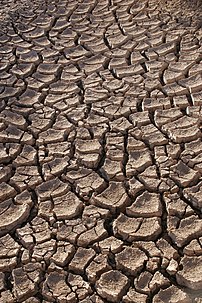 Image via Wikipedia
Image via WikipediaHow to Conserve Water During a Drought by Allen Owen
This scene is familiar to anyone who has experienced a particularly oppressive summer. The soil cracks in a thousand places, looking like the skin of a lizard. Plants begin to wither, and change from green, to yellow, to brown, from lack of water. The air seems to be thick and heavy, and heat distortion makes the air seem to rise from the ground, making the air seem to shimmer. Everyone seems to be in an ill mood, no matter how well their day is going, and how much progress they have made at school or work.
A drought-stricken area is in a poor state, but it is not hopeless. Even with very little water, you can deal with the scarcity and still emerge with a wallet filled with enough money to pay the rest of your bills. Even with very little water, a cooperative community can pull through a drought and enjoy the rains when they finally arrive.
If you live in a drought-stricken area, you will need to utilize every method of water conservation available. Here are a few tips that you might want to follow as you work on keeping what water you have.
Instead of soaking in a tub or using a pail and dipper to take a bath, take a brief shower. Soaking in a tub will only force you to fill up a tub with gallons of water that you might not end up using. A pail and dipper might make you careless, so that you splash water everywhere and end up using more than a bucket to clean yourself.
A shower, on the other hand, can force you to regulate the use of water. Confine your shower to no more than fifteen minutes. Turn off the shower while you shampoo, or while you soap your body. To save more water, wet your entire body, turn off the shower, then apply your shampoo and start soaping yourself. Rinse your entire body all at once. It was (and may still be) a common practice in the US Navy to shower in this fashion. Ships can make their own fresh water, but it was common to shower in this fashion anyway, since with so many crew taking showers, the fresh water making equipment may not be able to keep up with demand.
To save even more water, have a bucket standing by as you shower. Collect your shower water in the bucket, and use it to flush your toilet. When you flush, you can use up to five gallons of water each time you flush! This may differ, depending on what kind to toilet you have in your home. Save this water for more useful purposes, such as washing the dishes and your body. You can use your bath water to flush your toilet, and a bucket will usually be enough.
Don't use soapy dishwater water to water plants. This may seem like a good water conservation method, you also need to remember that the detergents in soap can damage plants and destroy nutrients in the soil. It is better, instead to control the amount of water you use to water your garden. Instead of using a hose or a sprinkler, take a small bucket of water and water plants with moderation. Too much water can weaken their roots and stems.
Health consideration are paramount, so analyze each decision that you make before conserving water. When rinsing dishes, don't soak them in a basin of water along with the rest of the dirty dishes. This practice can lead to bacteria and fungi accumulating on your utensils. Don't reuse bath water for any other purpose, except to flush your toilet. The dirt from your body can do more damage to your plants if you water them with your bath water. Don't conserve your drinking water! You need at least eight glasses of water a day to remain hydrated; you can go longer without food than without water! If you are in a drought-stricken area, you are more prone to dehydration, so don't scrimp drinking water.
If you don't finish the water in your glass, don't pour it down the drain. Put the water into a bucket, where it can be used to flush your toilet later. If the drinking water you have left is relatively clean, you can use it to water your plants. Don't give your half-consumed glass of water to your pet: your mouth can have bacteria and viruses that can make your pet sick.
Save on water by using paper plates that you can throw away after use. If you find paper plates expensive, you can also use paper plate safe wax covers, which are cheaper, and which can be discarded after use. You can also use cheap paper cups. These will save you money, and they can be recycled.
By following these simple tips, you can conserve water during severe droughts and save some money at the same time.
Allen Owen is an engineer and writes on various topics concerning energy conservation and alternative energy and fuel on his blog, Maxwell's Demon at http://www.alternate-energy4you.com/alternate-energy4you-blog/.
Article Source: http://EzineArticles.com/?expert=Allen_Owen
http://EzineArticles.com/?How-to-Conserve-Water-During-a-Drought&id=1891967
![Reblog this post [with Zemanta]](http://img.zemanta.com/reblog_e.png?x-id=a288d312-db3e-4280-b334-3ccb10e2e7bf)
No comments:
Post a Comment